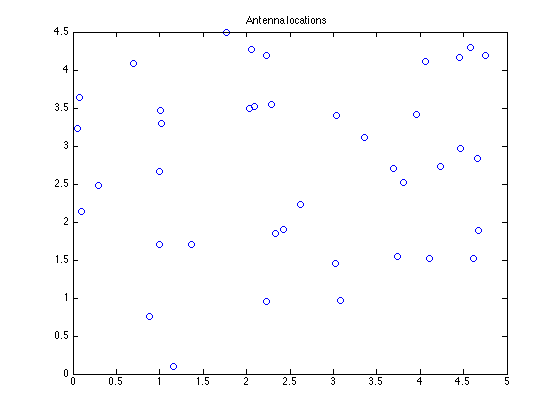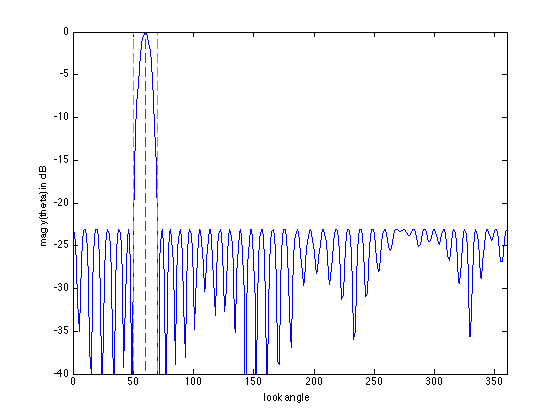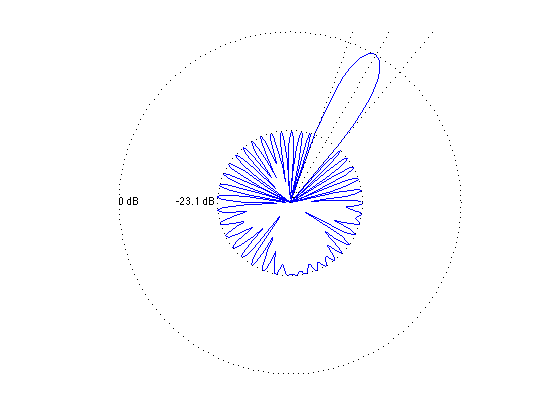ARRAY_GEOMETRY = '2D_RANDOM';
HAS_NULLS = 0;
lambda = 1;
theta_tar = 60;
half_beamwidth = 10;
if HAS_NULLS
theta_nulls = [95 110 120 140 225];
end
if strcmp( ARRAY_GEOMETRY, '2D_RANDOM' )
rand('state',0);
n = 40;
L = 5;
loc = L*rand(n,2);
angleRange = 360;
elseif strcmp( ARRAY_GEOMETRY, '1D_UNIFORM_LINE' )
n = 30;
d = 0.45*lambda;
loc = [d*[0:n-1]' zeros(n,1)];
angleRange = 180;
elseif strcmp( ARRAY_GEOMETRY, '2D_UNIFORM_LATTICE' )
m = 6; n = m^2;
d = 0.45*lambda;
loc = zeros(n,2);
for x = 0:m-1
for y = 0:m-1
loc(m*y+x+1,:) = [x y];
end
end
loc = loc*d;
angleRange = 360;
else
error('Undefined array geometry')
end
theta = [1:angleRange]';
A = kron(cos(pi*theta/180), loc(:,1)') + kron(sin(pi*theta/180), loc(:,2)');
A = exp(2*pi*i/lambda*A);
[diff_closest, ind_closest] = min( abs(theta - theta_tar) );
Atar = A(ind_closest,:);
if HAS_NULLS
Anull = []; ind_nulls = [];
for k = 1:length(theta_nulls)
[diff_closest, ind_closest] = min( abs(theta - theta_nulls(k)) );
Anull = [Anull; A(ind_closest,:)];
ind_nulls = [ind_nulls ind_closest];
end
end
ind = find(theta <= (theta_tar-half_beamwidth) | ...
theta >= (theta_tar+half_beamwidth) );
if HAS_NULLS, ind = setdiff(ind,ind_nulls); end;
As = A(ind,:);
cvx_begin
variable w(n) complex
minimize( max( abs(As*w) ) )
subject to
Atar*w == 1;
if HAS_NULLS
Anull*w == 0;
end
cvx_end
disp(['Problem is ' cvx_status])
if ~strfind(cvx_status,'Solved')
return
end
min_sidelobe_level = 20*log10( max(abs(As*w)) );
fprintf(1,'The minimum sidelobe level is %3.2f dB.\n\n',...
min_sidelobe_level );
figure(1), clf
plot(loc(:,1),loc(:,2),'o')
title('Antenna locations')
if angleRange == 180,
theta = [1:360]';
A = [ A; -A ];
end
y = A*w;
figure(2), clf
ymin = floor(0.1*min_sidelobe_level)*10-10; ymax = 0;
plot([1:360], 20*log10(abs(y)), ...
[theta_tar theta_tar],[ymin ymax],'r--',...
[theta_tar+half_beamwidth theta_tar+half_beamwidth],[ymin ymax],'g--',...
[theta_tar-half_beamwidth theta_tar-half_beamwidth],[ymin ymax],'g--');
if HAS_NULLS
hold on;
for k = 1:length(theta_nulls)
plot([theta_nulls(k) theta_nulls(k)],[ymin ymax],'m--');
end
hold off;
end
xlabel('look angle'), ylabel('mag y(theta) in dB');
axis([0 360 ymin ymax]);
figure(3), clf
zerodB = -ymin;
dBY = 20*log10(abs(y)) + zerodB;
ind = find( dBY <= 0 ); dBY(ind) = 0;
plot(dBY.*cos(pi*theta/180), dBY.*sin(pi*theta/180), '-');
axis([-zerodB zerodB -zerodB zerodB]), axis('off'), axis('square')
hold on
plot(zerodB*cos(pi*theta/180),zerodB*sin(pi*theta/180),'k:')
plot( (min_sidelobe_level + zerodB)*cos(pi*theta/180), ...
(min_sidelobe_level + zerodB)*sin(pi*theta/180),'k:')
text(-zerodB,0,'0 dB')
tt = text(-(min_sidelobe_level + zerodB),0,sprintf('%0.1f dB',min_sidelobe_level));
set(tt,'HorizontalAlignment','right');
theta_1 = theta_tar+half_beamwidth;
theta_2 = theta_tar-half_beamwidth;
plot([0 55*cos(theta_tar*pi/180)], [0 55*sin(theta_tar*pi/180)], 'k:')
plot([0 55*cos(theta_1*pi/180)], [0 55*sin(theta_1*pi/180)], 'k:')
plot([0 55*cos(theta_2*pi/180)], [0 55*sin(theta_2*pi/180)], 'k:')
if HAS_NULLS
for k = 1:length(theta_nulls)
plot([0 55*cos(theta_nulls(k)*pi/180)], ...
[0 55*sin(theta_nulls(k)*pi/180)], 'k:')
end
end
hold off
Calling SDPT3: 1366 variables, 422 equality constraints
For improved efficiency, SDPT3 is solving the dual problem.
------------------------------------------------------------
num. of constraints = 422
dim. of socp var = 1023, num. of socp blk = 341
dim. of linear var = 341
dim. of free var = 2 *** convert ublk to lblk
*******************************************************************
SDPT3: Infeasible path-following algorithms
*******************************************************************
version predcorr gam expon scale_data
NT 1 0.000 1 0
it pstep dstep pinfeas dinfeas gap prim-obj dual-obj cputime
-------------------------------------------------------------------
0|0.000|0.000|4.4e+02|2.1e+02|2.4e+05|-2.746283e-10 0.000000e+00| 0:0:00| chol 1 1
1|0.988|0.993|5.1e+00|1.7e+00|2.8e+03|-5.910542e-04 -3.754743e+01| 0:0:00| chol 1 1
2|0.996|1.000|1.8e-02|3.0e-02|4.3e+01|-1.073909e-04 -3.294803e+01| 0:0:00| chol 1 1
3|1.000|0.981|2.6e-06|7.1e-03|2.8e+00|-1.796667e-04 -2.767530e+00| 0:0:00| chol 1 1
4|1.000|0.889|6.0e-06|1.1e-03|6.9e-01|-3.329714e-03 -6.951011e-01| 0:0:00| chol 2 2
5|1.000|0.330|2.8e-06|7.2e-04|4.8e-01|-5.429149e-03 -4.885746e-01| 0:0:00| chol 2 2
6|1.000|0.198|3.0e-06|5.8e-04|4.0e-01|-9.246853e-03 -4.104552e-01| 0:0:00| chol 2 2
7|1.000|0.482|4.2e-07|3.0e-04|2.4e-01|-1.445314e-02 -2.511027e-01| 0:0:00| chol 2 2
8|0.886|0.301|2.3e-07|2.1e-04|1.7e-01|-2.381270e-02 -1.966532e-01| 0:0:00| chol 2 2
9|0.786|0.273|1.2e-07|1.5e-04|1.3e-01|-3.394599e-02 -1.629322e-01| 0:0:00| chol 2 3
10|0.880|0.310|7.9e-08|1.1e-04|8.9e-02|-4.555408e-02 -1.348750e-01| 0:0:01| chol 2 2
11|0.865|0.832|1.6e-08|3.2e-05|2.5e-02|-5.529792e-02 -8.055960e-02| 0:0:01| chol 2 2
12|0.709|0.931|5.4e-09|7.8e-06|1.0e-02|-6.356599e-02 -7.375485e-02| 0:0:01| chol 2 2
13|0.667|0.933|1.9e-09|3.1e-06|4.2e-03|-6.697687e-02 -7.115279e-02| 0:0:01| chol 2 2
14|0.824|0.941|6.4e-10|1.3e-06|1.3e-03|-6.924836e-02 -7.050785e-02| 0:0:01| chol 3 2
15|0.846|0.816|3.7e-10|3.8e-07|3.8e-04|-6.998889e-02 -7.036806e-02| 0:0:01| chol 3 3
16|0.844|0.908|3.7e-10|1.1e-07|1.3e-04|-7.018825e-02 -7.032177e-02| 0:0:01| chol 3 3
17|0.954|0.944|3.6e-10|4.0e-08|2.1e-05|-7.028439e-02 -7.030500e-02| 0:0:01| chol 3 4
18|0.945|0.904|1.2e-09|6.3e-09|3.5e-06|-7.029929e-02 -7.030261e-02| 0:0:01| chol 5 5
19|0.914|0.857|3.3e-09|1.1e-09|9.0e-07|-7.030163e-02 -7.030222e-02| 0:0:01| chol 6 5
20|0.896|0.951|6.8e-09|3.3e-10|2.1e-07|-7.030246e-02 -7.030211e-02| 0:0:01| chol 10 12
21|0.615|0.944|6.2e-09|2.6e-10|1.1e-07|-7.030271e-02 -7.030210e-02| 0:0:01| chol 9 10
22|0.616|0.943|5.0e-09|3.8e-10|5.7e-08|-7.030275e-02 -7.030209e-02| 0:0:01| chol 11 10
23|0.612|0.943|6.5e-09|5.6e-10|3.1e-08|-7.030268e-02 -7.030209e-02| 0:0:01| chol
linsysolve: Schur complement matrix not positive definite
switch to LU factor. lu 12 3
24|0.613|0.943|6.5e-09|8.4e-10|1.6e-08|-7.030281e-02 -7.030209e-02| 0:0:01|
stop: max(relative gap, infeasibilities) < 1.49e-08
-------------------------------------------------------------------
number of iterations = 24
primal objective value = -7.03028095e-02
dual objective value = -7.03020909e-02
gap := trace(XZ) = 1.63e-08
relative gap = 1.43e-08
actual relative gap = -6.30e-07
rel. primal infeas = 6.48e-09
rel. dual infeas = 8.44e-10
norm(X), norm(y), norm(Z) = 5.6e-01, 1.1e+02, 1.5e+00
norm(A), norm(b), norm(C) = 1.7e+02, 2.0e+00, 2.4e+00
Total CPU time (secs) = 1.35
CPU time per iteration = 0.06
termination code = 0
DIMACS: 6.5e-09 0.0e+00 1.0e-09 0.0e+00 -6.3e-07 1.4e-08
-------------------------------------------------------------------
------------------------------------------------------------
Status: Solved
Optimal value (cvx_optval): +0.0703021
Problem is Solved
The minimum sidelobe level is -23.06 dB.


